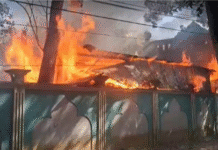About three-quarters of the world’s weapons are provided by just five countries: the U.S., Russia, China, Germany and France. The face of conflict is constantly changing, but this list has remained the same for the past 50 years.
The U.S. is the undisputed king of the arms trade. Responsible for 30 percent of weapon sales worldwide, it has a long-standing client base. It is the main arms provider for Central America, where arms imports since 2007 have increased by 68 percent, and exports 27 percent to the Middle East — mainly to Iraq and Afghanistan.
GLOBAL ARMS TRADE, GIVE AND TAKE
17 Percentage increase in volume of international transfers of major conventional weapons from 2007 to 2012
74 Percentage of international arms exports sold by the U.S., Russia, Germany, France and China
32 Percentage of international arms imports received by India, China, Pakistan, South Korea and Singapore
Russia is not far behind. The country has faced severe criticism for providing 78 percent of Syria’s weapons imports between 2006 and 2011. Yet 65 percent of Russian sales go to Asia and Oceania, and India is its largest client, not to mention the biggest buyer worldwide after increasing its demand by 52 percent in the past five years.
China comes after Russia, and in 2012 it even surpassed the U.K. in arms sold. While also being the world’s second largest buyer, its exports rose by 162 percent between 2007 and 2012, mostly directed to Asia (74 percent) and to Africa (13 percent).
Arrmed conflicts are estimated to cost Africa $18 billion a year — about the same it receives in international aid. Yet in Burundi you can buy a grenade for the price of a pint of beer. The continent’s overall imports have increased by 104 percent in the past five years — and by 350 percent in North Africa due to existing conflicts in Egypt and Libya and the fear of future ones in Algeria and Morocco.

Meanwhile in Europe, trade is slowing down. Since 2007, the other two major arm providers — Germany and France — have seen their sales decrease by 8 percent and 18 percent respectively. Political controversy has surrounded Germany’s trade with Saudi Arabia, the country that buys nearly a quarter of the German weapons and has become the world’s 10th largest arms importer.
Europe’s arms demand has decreased by 20 percent in the past five years, mostly due to the economic crisis. In 2011, Spain went ahead with the acquisition of 24 combat helicopters worth 1.4 billion euros, although Greece cancelled its order of over 400 armored vehicles from Russia.
Despite being mostly handled by states, the arms trade is a murky business. Nearly one million of the 7 to 8 million firearms produced every year are lost or stolen. Corruption in the global defense industry is estimated to cost $20 billion a year and since 2000 has allowed for more than $2.2 billion worth of arms to be imported into countries under arms embargoes.
This is why last April the international community decided to take action. After more than six years of negotiations, the United Nations adopted the Arms Trade Treaty, setting clear and safer rules for all global transfers of weapons and ammunitions. But the treaty has not been implemented yet. So far only eight of the 115 signatories have ratified it. According to Dr. Giles Giacca at the Oxford Institute for Ethics, Law and Armed Conflict, “Two of the world’s largest arms exporters — China and Russia — and the world’s largest arms importer — India — are not likely to sign or ratify the treaty in the years to come. It will be a very long process.”
Meanwhile every minute a person dies from armed conflict.
Source: ozy.com









